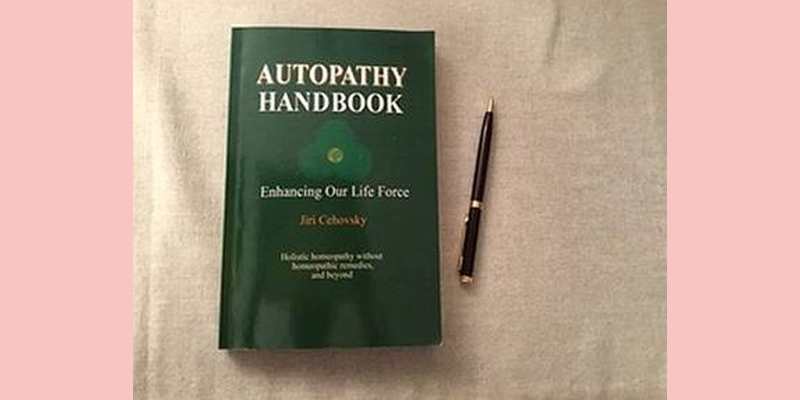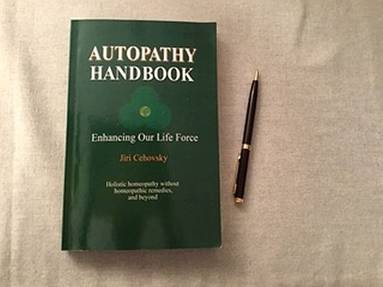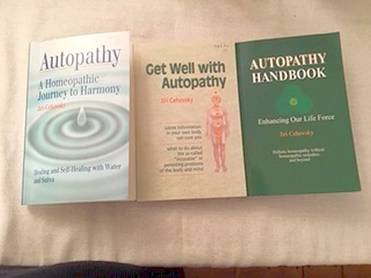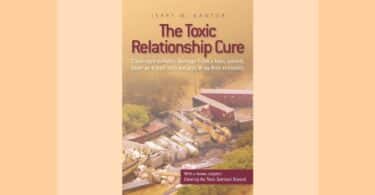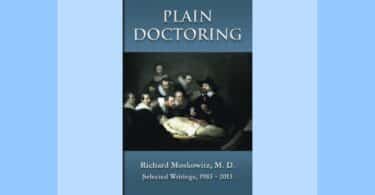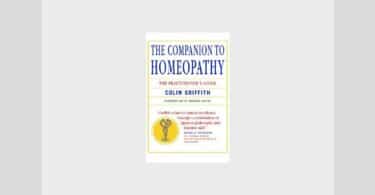Title: AutopathyHandbook, Enhancing Our Vital Force, Holistic HomeopathyWithout Homeopathic Remedies, and Beyond
Author: Jiri Čehovský
Published in 2019 by: www.autopathy.com
ISBN: 978-80-86936-52-9
Reviewer: Vatsala Sperling
Irrespective of how long we have been practicing homeopathy, we all recall experiencing beginner’s luck. A patient walks in, talks in the language of rubrics, a simillimum jumps right out, we give a remedy and boom, he becomes as fit as a fiddle! These few patients get all their complaints resolved and become healthy in the realm of their body, mind and emotions in the shortest time and with the least bit of homeopathic intervention. However, for most of us, such miracles do not happen everyday. In the rest of our practice, we routinely deal with the following scenarios:
- The case taking points to partial pictures of several different remedies. Even with our best and latest homeopathy software, we are perplexed as to which remedy to choose. The patient comes back with partial resolution of his complaints. We keep moving from one remedy to the next emerging remedy in our search for a perfect simillimum. During this time, the patient might get worse, and might leave our practice only to go to other practitioners, or worse still, he might stop using homeopathy altogether and joins the skeptics declaring,’homeopathy does not work’. (Ouch!)
- At the end of case taking, we are flailing desperately amongst a sea of symptoms and have no idea what remedy to give. Our own innate ignorance gets an opportunity to shine brilliantly.
- Some casesarevery layered, twisted, complicated, influenced by input from different alternative and conventional practitioners. As homeopaths, we do not get to clearly understand such cases,let alone pull the patient out from underneath the rubble of eight different allopathic drugs that he might currently be on.
- Or, the patient is so far gone in his illness that we are motivated to give up rather than try heroic measures to mend the incurable situation.
I can confidentially say that these scenarios are experienced not just by new homeopaths, but also by those who have been practicing for many decades. Some of my teachers are very fond of saying that homeopathy is human-centric, but I am yet to hear any seasoned homeopath say to me, homeopathy is as straight as 2+2=4.
So yes, just to survive in the highly competitive world of alternative practitioners, and to give our clients an opportunity to heal and experience wellness, we are always in the lookout for a new tool that will keep our practice from rusting and becoming stale. We need to maintain a sharp edge.
As I was thinking along these lines, I received a book for review: “Autopathy handbook: Enhancing our life force, holistic homeopathy without homeopathic remedies and beyond” (2019) by Jiri Čehovský. I was so intrigued that I bought two more books written by Jiri, Autopathy, A Homeopathic Journey to Harmony(2011) and Get well with Autopathy (2012). I read these books in the sequence in which they were written. I read every word on his website and tried to understand what Autopathy is all about, how, where, when, why it can be used, and who can use it. I am happy to have spent the time studying these books, and if you face the four scenarios mentioned at the outset with regards to your patients just as others (myself included) do from time to time, then you too will be happy to read these three books and consider your time well spent.
In his first book, “Autopathy, A Homeopathic Journey to Harmony, Jiri gives a lively summary of how people fall ill. He uses the term, ‘frequency’ to make his point (pages 32-34). He points out that homeopathy is not only based on the principle ‘similasimilbuscurantur’, it is also based on ‘equality equilibuscurantur’ and thus we naturally gravitate toward prescribing remedies that are isopathic.
An example is giving potentized vaccine to people whose pathology stems from vaccination. We also do understand, as Dr. Lux had explained, ‘all contagious diseases carry with them in the shape of their infectious matter their curative remedy.’ There is a detailed account of the French homeopath, O A Julian, treating a very severe case of Herpes Simplex using the principle of isopathy or auto-isopathy (disease secretion from a sick person is potentized and used for treating him).
However, Jiri Čehovský contends that isopathy and auto-isopathy are not cent per cent a holistic form of treatment. In his search for a truly holistic, Hahnemannian concept, ‘Homeopathy does not cure the illness, but it cures the person who is experiencing illness’ Jiri has chosen ‘Autopathy’ as a term that is not burdened by any pathological connotations. He writes that Autopathy does not seek a simillimum, or a similar medicine, and it does not use any homeopathic medicines at all. But Autopathy has its philosophical and historical roots in homeopathy as well as in the teachings of Buddha, Swedenborg, Kabbalah, Indian and Celtic shamans, yogis, early Christians, Rosicrucians, sufis, people practicing channeling (mental communication with higher dimensions) and many others.
According to Jiri, Autopathy is essentially a spiritual medicine and an individual’s journey to connect with higher levels of the universe so that his health improves at the level of the body, the mind, the emotions as well as his spirit. One heals spiritually and this healing is experienced as harmony in one’s being.
In his second book, Get well with Autopathy, the subtitle mentions what to do about the so-called “incurable”or persistent problems of the body and mind. This book gives further clarity and details how to use Autopathy to bring about cure. The brief chapters about animals and plants receiving benefit from use of Autopathy medicine are beautiful…and there is no placebo effect happening there!
Jiri’s latest book, AutopathyHandbook, Enhancing Our Life Force, Holistic Homeopathy Without Homeopathic Remedies and Beyond(2019) summarizes Jiri’s journey in the realm of Autopathy and its application for healing. Just as a handbook should, this book carries full information about the process of Autopathy. I will not go into chapter-wise details about this book, but I will tell you that after reading this book and the two previous books by this author, I came away with the feeling that Autopathy is simple enough that it can be done by practitioners for themselves and their patients. It is simple enough (emphasis again) that it can also be done by people in the privacy of their own homes for self treatment. In eight parts or chapters, Jiri has successfully made a point about the ease and simplicity as well as effectiveness of Autopathy.
While studying these books and trying to understand the scope of Autopathy, I did communicate with a well known homeopath who uses Autopathy frequently for maintaining balance and harmony in his health, and asked him a few questions. This is what he had to say:
Does practice of Autopathy mean that there is no longer a need for homeopathic case taking?
“Autopathic remedies are generally used as intercurrent remedies, so it isn’t either-or. The best of both worlds. You still need to take a case because you’ll be using both autopathy and regular remedies. You also need to have a sense of the person’s vital force, so you can determine the dose and potency of autopathic remedies.
A healing system could not be any simpler, straightforward and dignified. It gives the power back to the individual.
In situations where you don’t have the conventional remedy, or you can’t determine it, this is a wonderful tool.
Another plus, is the autopathy bottle that Jiri Cehovsky created. With it, you can make a 200 c or higher in a few minutes. You can always make the remedy the standard way, with dilutions and succussions, but faster is nice too.
Jiri believes that it’s best to deal with parasites before doing other methods of autopathy, so I started off trying it for Candida with myself and some of my patients. You bring first morning saliva (and whatever else can be coughed up) just to boiling and then potentize it. I’d had a lot of antibiotics as a child and was still dealing with candida. I had tried the usual remedies and a number of other options (essential oils, food grade peroxide etc.) Some things worked, but it always came back. After doing autopathy just a couple times it stayed away for months. I repeat it now and then. My patients had similar experiences.I then tried it for a patient who was experiencing depression. She used her breath from her nostrils and put the remedy on her forehead. There was significant improvement. I’ve used it for allergic reactions to foods with equal success… and so forth.
It’s important to follow his directions a much as possible. If you use an autopathy bottle and intend to boil saliva, I suggest doing the boiling in a new stainless steel spoon, and then pouring it into the bottle, instead of boiling it in the autopathy bottle. “
So, it is clear that Autopathy does not replace good old homeopathic case taking and the treasure trove of thousands of homeopathic remedies proven and used over the past 250 years. It is just another way, alongside homeopathy, that could be of help to our patients.
So what is to be done? If you are one of those practitioners who gets absolutely 100% success with each one of your patients, then of course you need not be curious about the potential and possibilities of Autopathy. However, if you belong to the category of lesser mortals who are continuously striving to stay sharp and remain helpful to their patients ( particularly those with very complicated, excessively treated and non-responsive cases) then do go for all three of Jiri’s books and actually explore Autopathy in depth. You can make it yet another useful tool in your ever-growing kit.
We live in a world which is very different from the one in which our grandparents lived. We are immersed in toxic chemicals from the environment including our food, water and air. We live and breathe in an atmosphere that is saturated with radiations. We are over diagnosed, over-tested, over-prescribed and even with enormous medical bills, we continue to be a race plagued with an endless stream of illnesses. It is amazing that we have not mutated into some other species and we continue to remain Homo sapiens. Jiri’s Autopathy books go into the simplest aspects of humanness. Our vital force is expressed in our saliva which is considered the most perfect fluid for Autopathy and the frequency of saliva is most closely related to the frequency of ourselves in our best health, even in the midst of our illness. No matter how ill we are, so long as we are alive, our vital force is still present and functioning and we are still producing saliva. Autopathy gives us an easy to follow method to explore the healing potentials of potentized saliva for restoring harmony, and for this very simple reason, you might want to consider studying Autopathy in depth and see if it has a place in your life and your practice.

